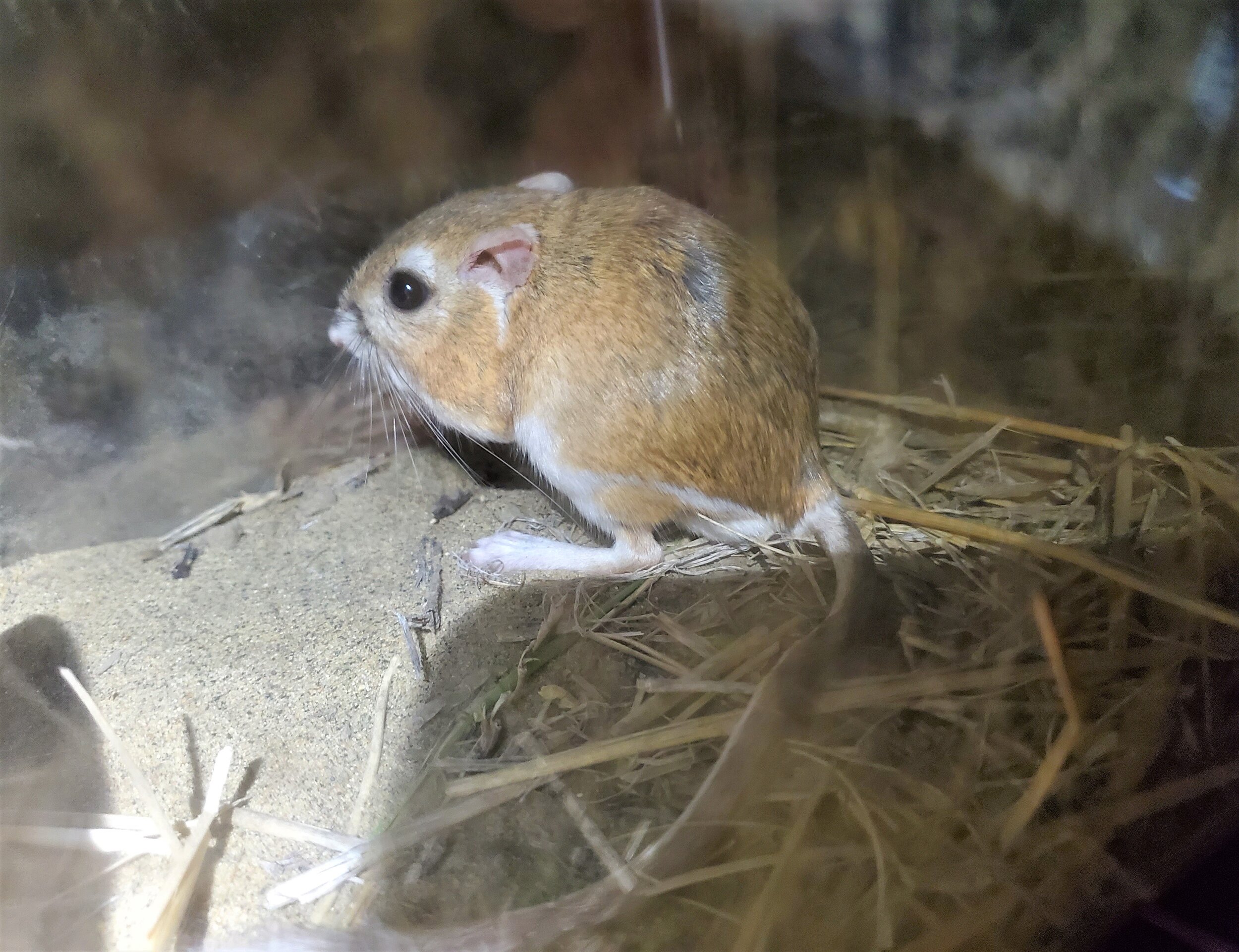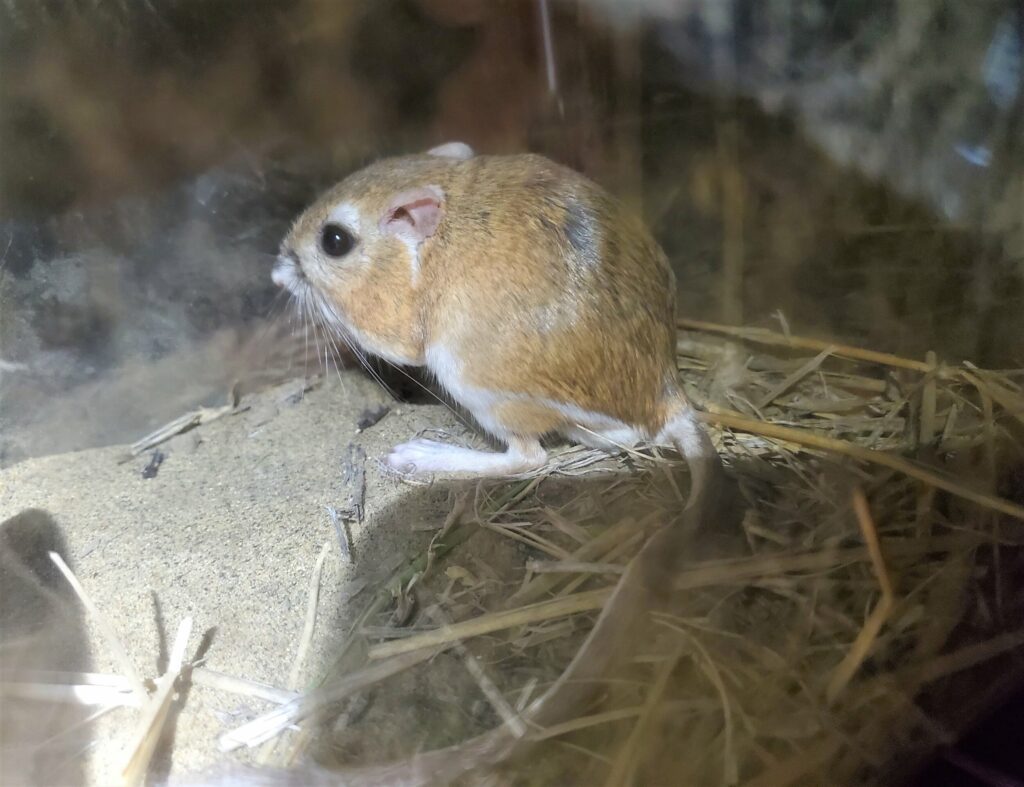Headlamps flickering in the darkness, the sounds of sand being kicked, a shout, and the chase is on! AJM biologists sprint through the darkness in hot pursuit. Their quarry….an elusive animal, one that only comes out at night, is odorless, can leap up to 2 meters in a single bound, and uses aerial ninja kicks to defend itself from predators. Can you guess what it might be?
If you guessed the prairie Chupacabra, you’d be close but not quite right. The animal we were seeking was the elusive Ord’s kangaroo rat. With no close relation to the invasive Norway rat, nor the leggy marsupials from Australia, the Ord’s kangaroo rat is part of a distinct group of rodents specially adapted to life in hot, arid environments. Although their native habitat consists of sandy dunes along western Canada’s Sandhills region, diminishing habitat has caused these specialized rodents to adapt to life along rural roadways, soil piles, and cultivated fields. Recently, a small group was found living in the topsoil berms on a project construction site (within a cultivated field no less!). Due to their conservation status in Canada, AJM teamed up with client TC Energy, and provincial biologist Sandi Robertson, to take on the challenge of capturing and translocating these endangered rodents to greener pastures and sandier dunes.

Ord’s kangaroo rats are an amazing species, trust us, we could wax poetic for hours about their cute appearance and incredible adaptions. Instead, welcome to K-rat 101, an introduction to the wonderful world of Alberta’s nocturnal ninja.
Kangaroo rats are medium-sized rodents weighing in at an average of about 70 grams and between 20-28 cm nose to tail tip. They are highly territorial and live solitary lives; they will fiercely defend their burrows from other kangaroo rats or intruders. Each rat excavates a tunnel system underground or within a sandy dune connected by multiple entrances offering numerous escape routes when needed from predators.
Living low to the ground and being a small mammal leaves kangaroo rats at the bottom of the food chain. Their diet consists predominantly of seeds, which provide them with the nutrients they need and their complete supply of water. Kangaroo rats almost NEVER drink, and the moisture they gather from their food stays in their bodies. They rarely urinate, producing miniscule, concentrated droplets, and their nasal passages are specially designed to reclaim almost all water they lose from breathing. This adaption leaves them nearly odorless and predators trying to find them must rely on other senses.
Another way they escape predation is by coming out exclusively at night. Using their large ears and eyes, they prefer to navigate their world in the dark. They often avoid emerging on moonlit nights, preferring the cloak of total darkness to help prevent detection by predators.
When faced with a predator like a snake or a bird of prey, they use their kangaroo-esque hind legs to send them up to 2 meters in a single bound. And if that doesn’t work…well, things really kick off. One of the kangaroo rats’ most unique traits is their ability to strike in the blink of an eye. Channeling both the cryptic nature and the offensive tactics of Japan’s elite ninjas, kangaroo rats are fast enough to leap past a striking snake and kick in mid-air to avoid getting bit!
So, with all these adaptions at their disposal, why do Ord’s kangaroo rats find themselves on Canada’s list of Species at Risk? Despite their ability to evade predators, kangaroo rats are specially adapted to their environment. That means that as sandy soil habitat and natural sand dunes have been converted for agriculture and development, they have lost much of their native habitat. This has caused populations to become fragmented, with some ending up in relatively unsuitable habitats like along roads or cultivation where they are more susceptible to predators, death by motor vehicle, and parasites like bot flies. Additionally, in harsh winters, Ord’s kangaroo rat populations have been recorded to have almost 90% population loss from overwinter mortality. These population crashes, coupled with diminishing habitat, has left these nocturnal ninjas in peril. Now you can see why our rescue mission was so important.
Provincial biologist Sandi Robertson has been working for decades with Alberta’s kangaroo rats, particularly to restore their natural habitat and establish populations in productive, native sand dunes. Working together, Sandi gave the AJM and TC Energy team a crash course in kangaroo rat capture. Under the cover of darkness, and with patience, the team staked-out the soil berms, waiting quietly until the distinct sounds of scurrying could be heard. Quickly, we would snap our headlamps on and work as a team to block the burrow entrances and chase the rats away from the soil piles. One team member would chase the kangaroo rat until they froze and carefully collect them by hand, making sure to work gently around their legs, as they can be easily injured. Once captured, the rats were whisked off in small terrariums filled with sand, a hiding place, and plenty of native seed. Sandi then took the rats and translocated them to recently restored sand dune habitat where they will be able to live out their days, happy, healthy, and away from human disturbance.
AJM, along with TC Energy personnel, captured a total of four kangaroo rats and handed them over for translocation. After multiple days and nights with no k-rats observed or tracks seen, we underwent the final step and hand-excavated the burrow system. Inside we found a tunnel system with chambers packed with old seed stores, but no kangaroo rats. At last, with our mission complete, the project work resumed and the event was declared a win for both conservation and construction.
Contact us and see what we can do. From managing endangered species, to navigating environmental regulations, AJM is ready for action!
